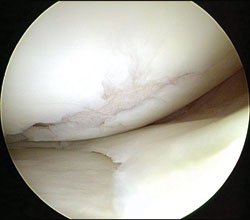Study identifies risk factors for revision of autologous chondrocyte implantation
 Pia M. Jungmann |
A study recently published in the American Journal of Sports Medicine highlighted previous knee surgery, bone marrow stimulation, periosteum patch covered technique and female gender as significant predictors of re-intervention after autologous chondrocyte implantation for cartilage defects of the knee.
The researchers examined eight other risk factors for re-intervention after autologous chondrocyte implantation (ACI) in 413 patients at a 2-year to 11.8-year follow-up that did not show a statistically significant influence, including body mass index, patient age, number of defects, defect size, parallel treatment, legion origin and location, and smoking. A subset of 88 patients of the 413 patients (23.1%) underwent revision surgery.
“We identified various risk factors associated with an increased risk for the need for re-intervention after ACI,” study investigator Pia M. Jungmann, MD, from the Department of Orthopedics and Trauma Surgery directed by Prof. Norbert P. Südkamp at Freiburg University Hospital in Germany, told Orthopedics Today. “All these factors should be taken into account when indicating ACI.”
Risk factors for ACI
In addition to analyzing each potential risk factor separately, the researchers used logistic regression models and a Cox regression model for survival analysis, including forward and backward regression, to strengthen results and to exclude differences in follow-up.
“With all these statistical analyses, we actually found the same result, which underlines the importance of this study because the same risk factors were filtered and identified in each model,” Jungmann said.
|
|
Images: Niemeyer P |
She added, “Risk for re-intervention is just one specific parameter in a complex context and only one outcome parameter. Need for re-intervention does not necessarily mean ‘treatment failure’ because these patients can still have a good outcome after this re-intervention and profit from ACI.”
Previous studies
Jungmann noted that the study builds on previous work conducted by head author, Philipp Niemeyer, MD, PhD. In one such study, Niemeyer and colleagues analyzed characteristic complications after ACI. In a further study, they discovered that ACI after failed microfracture was significantly associated with inferior outcomes. Additional studies concluded that cell quality during transplantation had an effect on the clinical outcome of ACI.
“We restricted the observation plan to 5 years to eliminate differences in the operation technique mainly, not only in the survival analysis but also in the other, statistical analyses. This would need to be extended in future studies,” Jungmann said, adding that the minimum 2-year follow-up study showed a mean time to failure of 1.8 years. – by Jeff Craven
References:
- Jungmann PM, Salzmann GM, Schmal HS, et al. Autologous chondrocyte implantation for treatment of cartilage defects of the knee: What predicts the need for reintervention? Am J Sports Med. 2012; 40:1:58-67.
- Niemeyer P, Pestka JM, Kreuz PC, et al. Characteristic complications after autologous chondrocyte implantation for cartilage defects of the knee joint. Am J Sports Med. 2008;36:2091-2099.
- Niemeyer P, Pestka JM, Salzmann GM, et al. Influence of cell quality on clinical outcome after autologous chondrocyte implantation. Am J Sports Med. 2011. Published online Dec 14, 2011.
- Pestka JM, Bode G, Salzmann G, et al. Clinical outcome of autologous chondrocyte implantation for failed microfracture treatment of full-thickness cartilage defects of the knee joint. Am J Sports Med. 2011. Published online Nov 5, 2011.

- Pia M. Jungmann, MD, can be reached at the Department of Radiology and Biomedical Imaging, Musculoskeletal and Quantitative Imaging Research, University of California San Francisco, 185 Berry St., Suite 350, San Francisco, CA 94107; email: pia.jungmann@ucsf.edu.
- Disclosure: Niemeyer received grants for limited educational purposes from TiGenix and Stryker.


